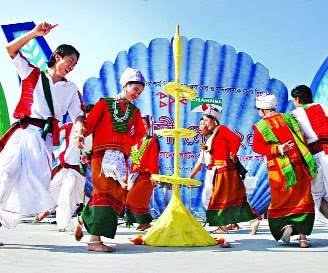Bangladesh is a nation of many ethnicities, cultures, religions and languages. The majority of Bangla-speaking people of this country, along with the Bengalis, are living for a long time, many small ethnic groups. They are distinct from Bengalis in ceremonies, ceremonies, religions, languages, reforms and cultures. These are integral and inevitable parts of Bangladesh.
Aborigines of the indigenous tribe, the word comes from the Latin word Aborigine, which means "the beginning" means the indigenous people living in a country are called indigenous people. On the other hand, small ethnic groups are generally meant to refer to minority and relatively backward disadvantaged communities or communities living in the main nation as well.

source
There are differences in the actual number of small ethnic groups in Bangladesh. As per the 1991 census, there are 29 small ethnicities in Bangladesh. Most of them live in mountainous areas of Chittagong Hill Tracts. According to the 2001 census, the number of indigenous people in Bangladesh is 3 lakh 64 thousand 775. However, according to the information provided by the Bangladesh Indigenous Forum, 45 small ethnic groups have been found and there are more than 20 lakh indigenous people. Among the small ethnic groups of Bangladesh, the ethnic groups such as Chakma, Marma, Rakhain, Tanchanga, Manipuri, Garo, Hajong, Santal, Khasia etc. They are living in the greater Chittagong Hill Tracts, Mymensingh, Sylhet, Rangpur, Dinajpur, Panchagarh, Rajshahi, Thakurgaon, Cox's Bazar, etc. for ages.
The largest community of small ethnic groups in Bangladesh is 'Chakma'. Chakmas themselves say that Chancha Their buses in the greater Chittagong Hill Tracts, especially Rangamati, Khagrachari, Bandarban etc. They are again divided into small groups. They have their own social, administrative and judicial system, with the main responsibility of the king. Rajai disposed of the customs, customs, land, revenue management, village disputes and various problems of Chakmas. Chakmas are socially patriarchal. As a result, only sons inherit the inheritance of paternal property. Although agriculture is their main occupation, at present, Chakmas have occupied employment and business. Among the indigenous communities, Chakmas have the highest literacy rate (37.7%). Their main religious and social festivals include Maghi Purnima, Baishakhi Purnima, Buddhist Purnima, Katha Chivar Dan, Honey Purnima, Fanus Lakh etc. One of the biggest festival of Chakmas is the Biju festival.

source
The second largest community in terms of the majority is 'Marma'. Marmas live in hill districts but they are mainly residents of Bandarban. They are called Marma because they came from Myanmar. But the word Marma comes from the word 'Meraima'. About 100,000 Marmas live in Bandarban. Like Chakmas, they have the responsibility of conducting social justice in the hands of the king. Despite the patriarchal society, Marma girls receive equal inheritance of paternal property. They earn livelihood by cultivating zum cultivation, river fish and crabs, and cloths, corms etc. But in the field of education, they are establishing themselves in other fields, including jobs, business and fast. Marmas use the Burmese alphabet to write in their own language. Marmara Buddhist religion. Their main religious and social festivals include Buddhist purnima, hard chevra donation, waagoyai etc.
 source
source
Tanchanga is one of the smallest ethnic groups in Bangladesh. They live in Rangamati and Bandarban districts. Though Tanchangya claims to be their own independent caste, anthropologists believe that they are a sub-group of Chakma Nation. In terms of socio-cultural customs, they have found quite similarities with Chakmas. The language of the Tanchangiyas consists of the Indo-Aryan language group. Tanchangyaa refers to it as 'Manbhasha'.

source




Excellent post on Bangladesh ethnic minority.
Posted using Partiko Android